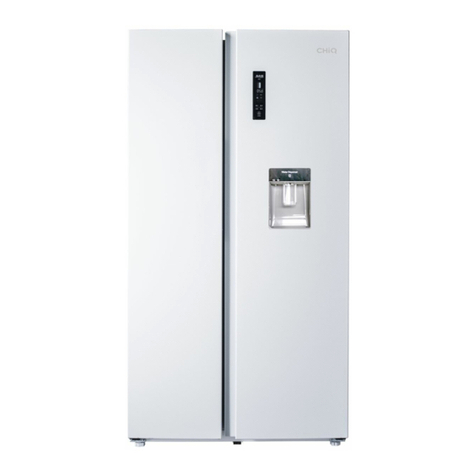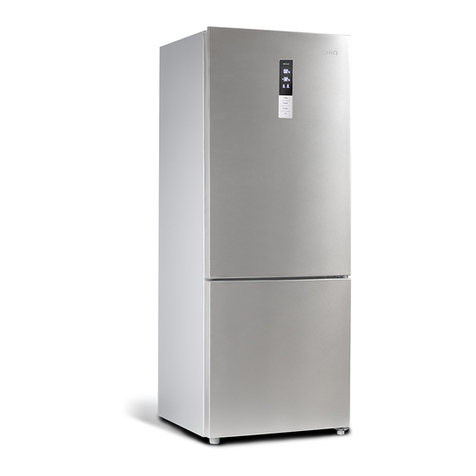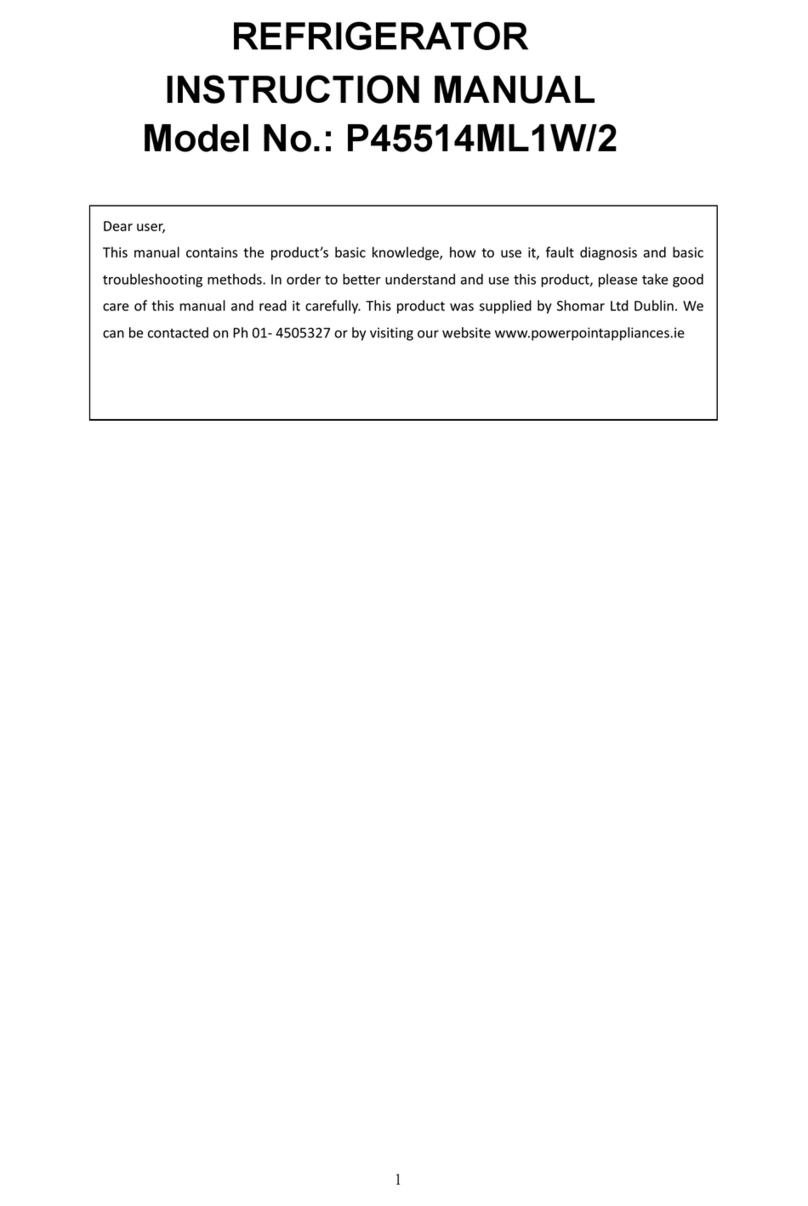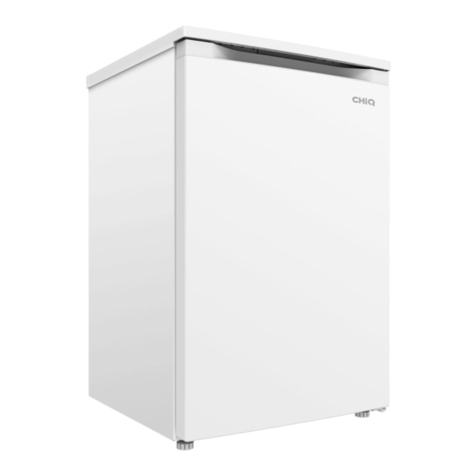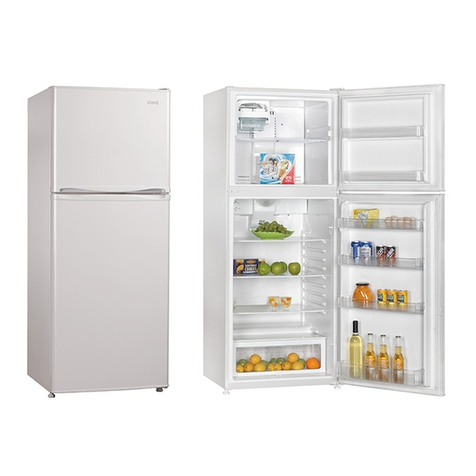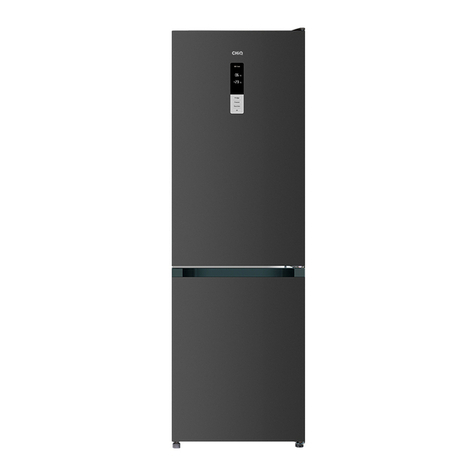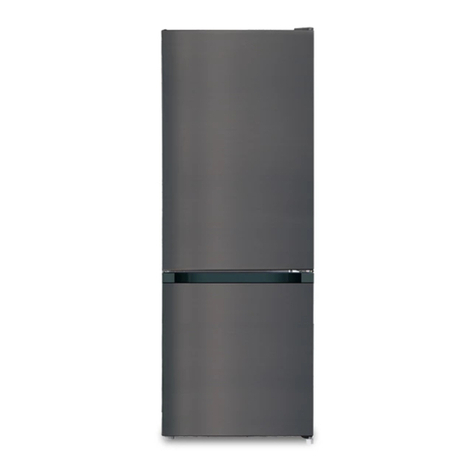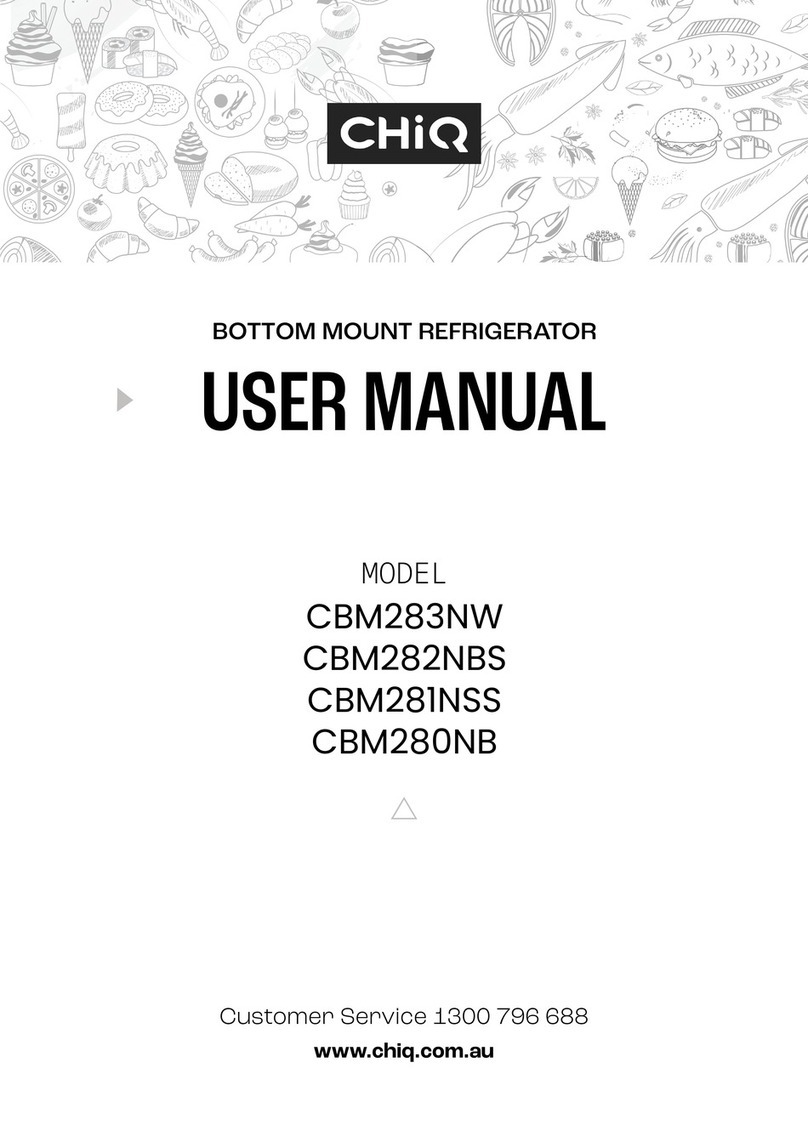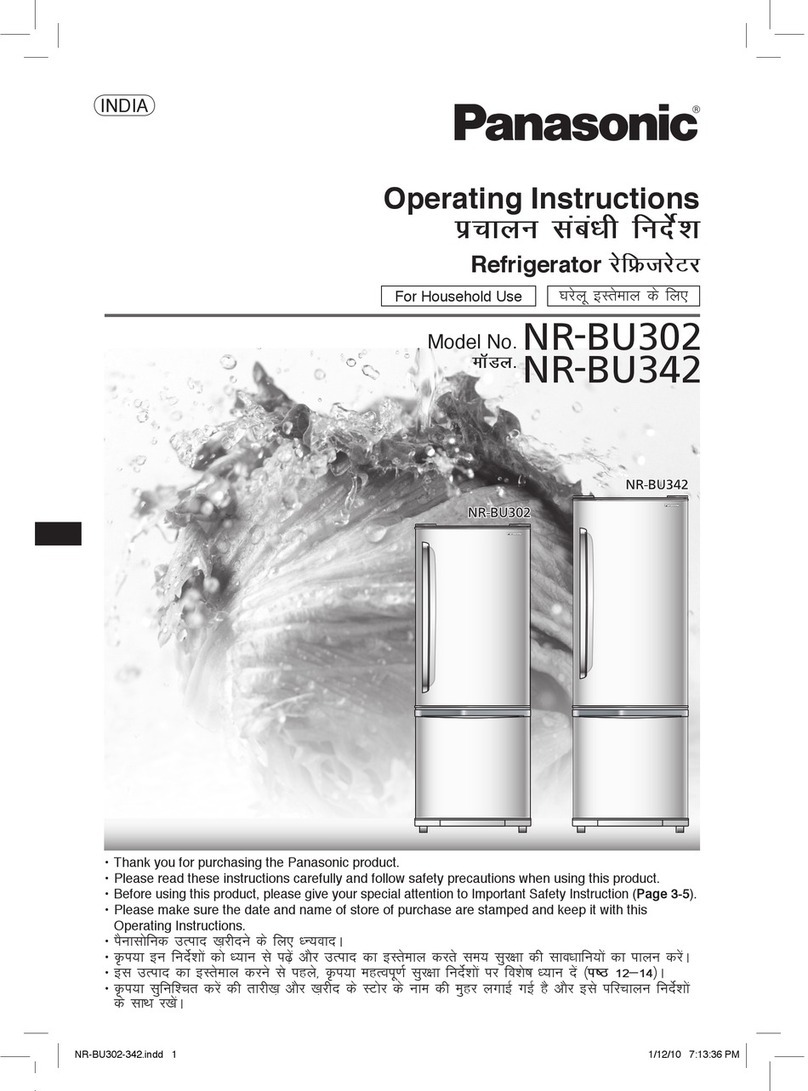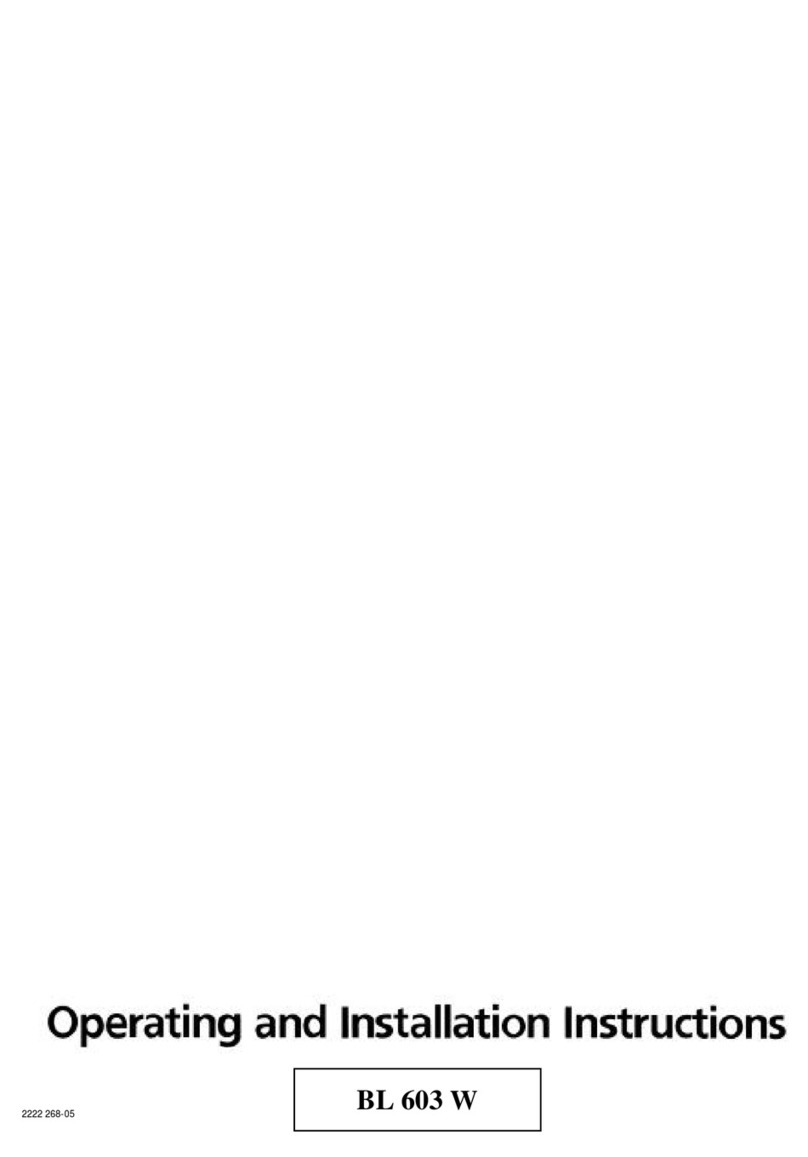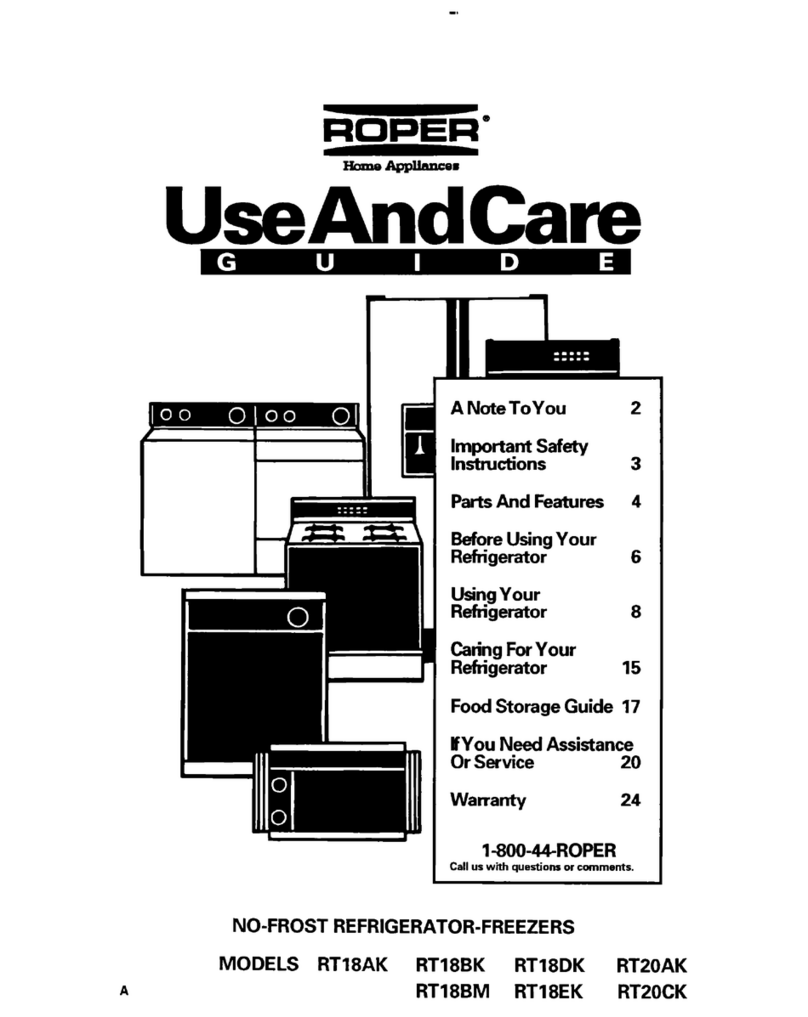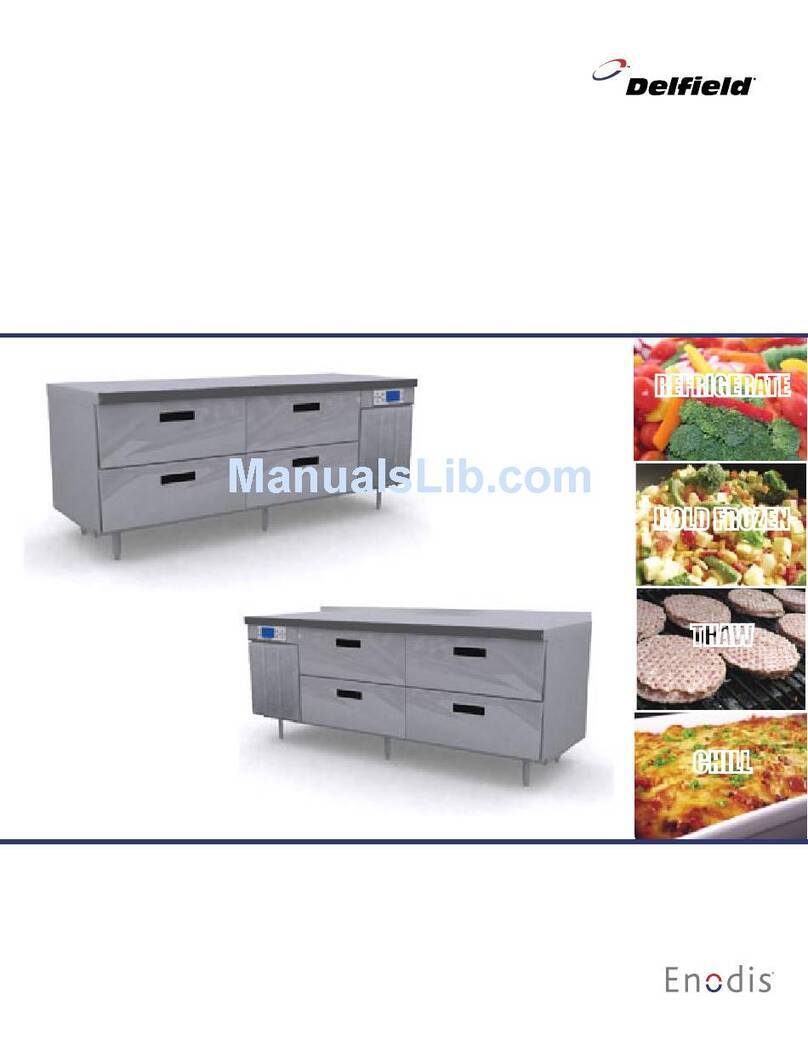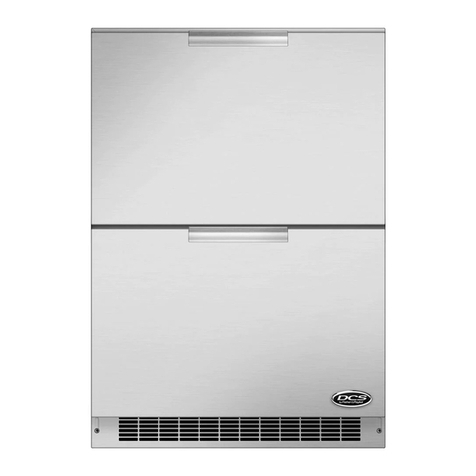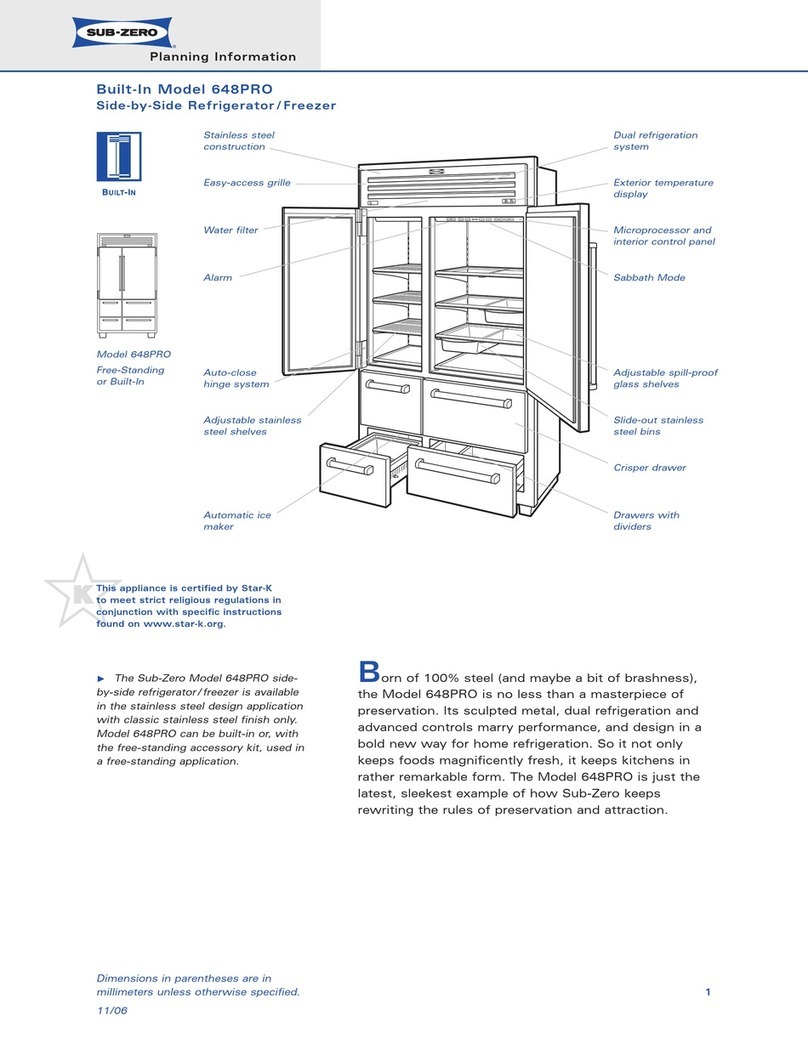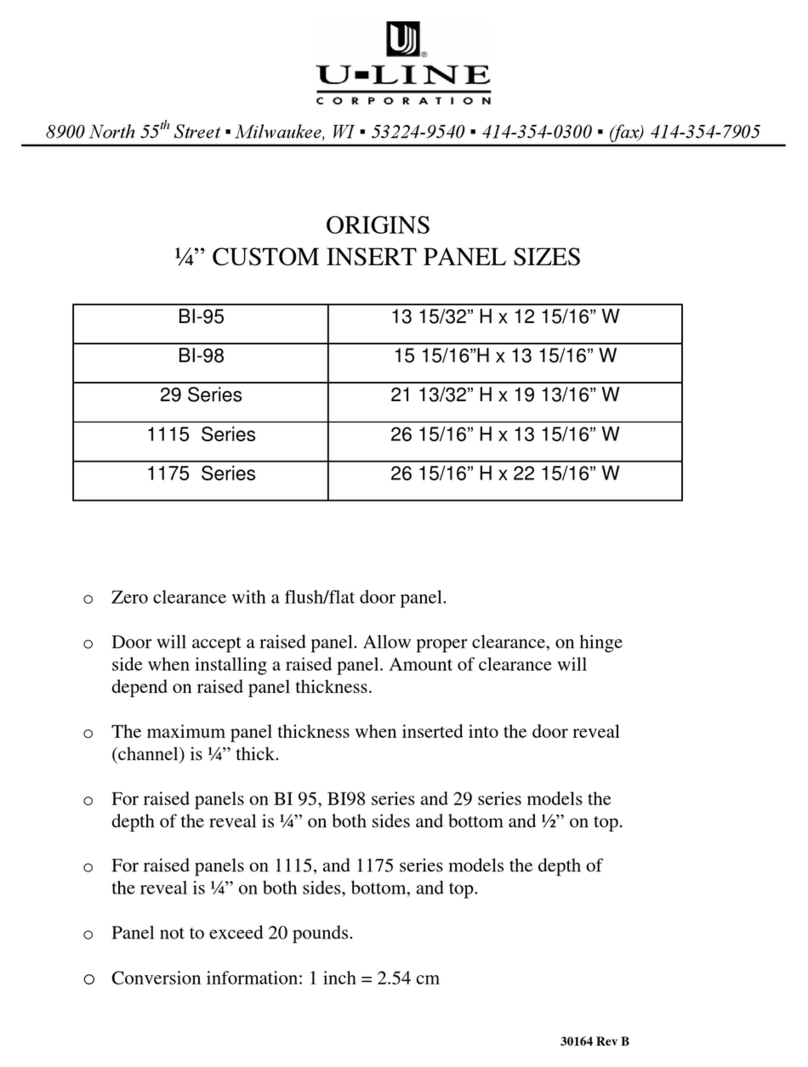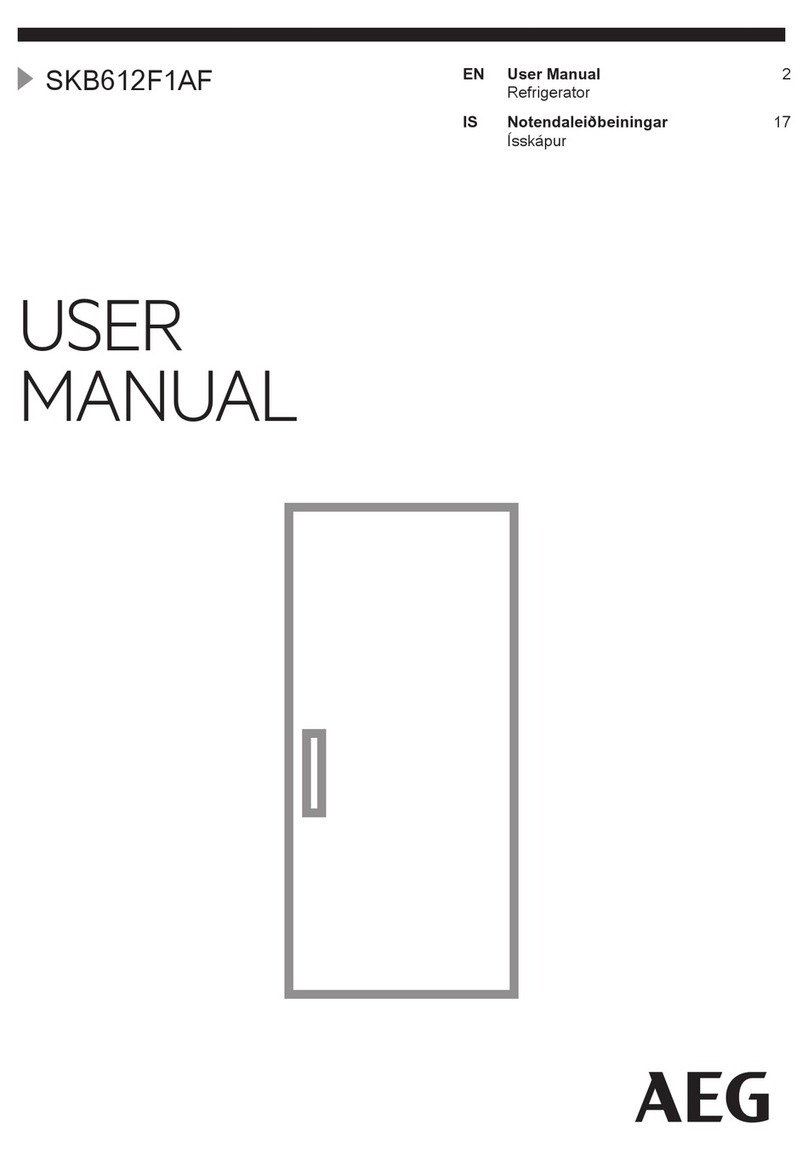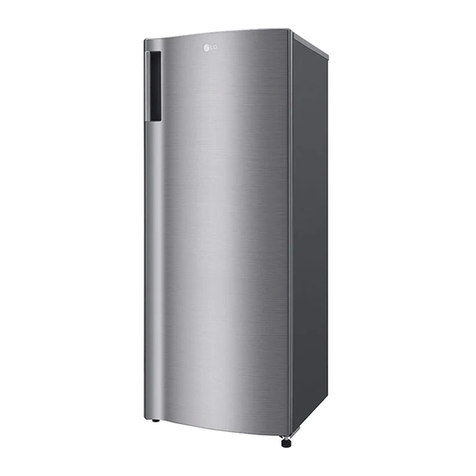ChiQ CBM117L42 User manual

技术要求: 版本号 物料编码/图
号
A01.....
1. 尺寸:32K;
2. 印刷颜色:封面105g铜版纸彩印,内容黑白色;
3. 材质:内容80g双胶纸
4. 样板需送设计部门封样
5. 制件必须满足《GF-07冰箱说明书、铭牌、能效
标识设计规范(E版)其它类似印刷件》技术规范
标记 变更内容 修改日期 签名
①
②
③
④
⑤
编制 王成年 审核 熊克念
批准 谢萍 时间

FBM117L
FBM157L
FBM157L1
FBM157L42
CPB157L
CPB157LB
CBM157L12
EN
FR
GE
ES
CZ
NL
CBM117L42
FBM157L4
CPB117L

EN
2
Contents
I. SAFETY............................................................................................................................................................3
II. Product features ............................................................................................................................................5
III. Preparationsforuse.....................................................................................................................................6
IV. Functions.........................................................................................................................................................7
V. Instructionsforfood storage......................................................................................................................7
VI. Tipsforspecial needs..................................................................................................................................8
VII. Maintenance and cleaning ..........................................................................................................................9
VIII. Simplefault analysisand elimination....................................................................................................10
IX. Certifications ................................................................................................................................................10
X. Saferecoveryinstructions........................................................................................................................10
Dearusers,this manualcontains the product sbasicknowledge,howto
use it,faultdiagnosis andbasictroubleshooting methods.Inorderto
betterunderstandand usethis product,please takegoodcareofthis
manualandreadit carefully.

EN
3
I.SAFETY
WARNING!
Itis hazardousforanyoneotherthan authorized servicepersonnel tocarryoutservicingorrepairswhichinvolvesthe
removal of covers. Toavoidtheriskofan electricshockdonot attempttorepair thisapplianceyourself.
WARNING!
Risk of fire/ flammable materials.
Safetytips
Donot useelectrical appliancessuchasahairdryer orheater todefrost yourFreezer.
Containerswithflammable gasesorliquidscanleakat lowtemperatures.
Donotstoreanycontainerswithflammablematerials,suchasspraycans,fireextinguisherrefill cartridgesetc.in the
Freezer.
Donotplacecarbonatedorfizzy drinks intheFreezercompartment.Icelolliescancause Frost/Freezeburns”if
consumed straight fromthe Freezer.
DonotremoveitemsfromtheFreezercompartmentifyourhandsaredamp/wet, asthiscouldcauseskin abrasionsor
Frost/Freezerburns”.Bottlesand cansmustnotbe placedin the Freezercompartmentastheycanburstwhen the
contentsfreeze.
Manufacturer’srecommendedstorage timesshouldbe adhered to. Refertorelevantinstructions.
Donotallowchildren totamperwiththe controlsorplaywiththe Freezer.The Freezerisheavy.Careshould betaken
when moving it. Itisdangeroustoalterthe specificationorattempttomodifythisproduct in anyway.
Donotstoreinflammable gasesor liquidsinsideyour Freezer.
If thepower cableisdamaged, itmustbe replacedbythemanufacturer,itsserviceagentor similarlyqualified personsin
order toavoidahazard.
Thisappliancecan beused bychildren agedfrom8yearsand aboveand personswithreduced physical,sensoryor
mental capabilitiesorlackofexperience and knowledge iftheyhavebeen given supervisionorinstruction concerning use
ofthe appliancein asafewayand understandthehazardsinvolved.Children shall notplaywiththe appliance.Cleaning
and usermaintenanceshallnot be madebychildren without supervision.
Thisapplianceisintended to be used in household and similar applicationssuchas
staff kitchen areasinshops,officesandother workingenvironments;
farmhousesand byclientsinhotels,motelsandother residential typeenvironments;
bed and breakfast type environments;
catering and similar non-retail applications.
Keep ventilation openingsinthe applianceenclosureorin the built-instructureclear ofobstruction.

EN
4
Donot usemechanical devicesor other meanstoacceleratethe defrosting process, otherthan thoserecommendedby
the manufacturer.
Donot damage the refrigerant circuit.
Donotstoreexplosivesubstancessuchasaerosolcanswithaflammable propellant inthisappliance.
–WARNING:Donotuseelectricalappliancesinside the foodstoragecompartmentsoftheappliance,unlesstheyareof
the type recommended bythemanufacturer.
–WARNING:Refrigerating appliances –in particulararefrigerator-freezerType I –mightnotoperateconsistently(thereis
possibilityof defrosting of contentsor temperaturebecoming too warmin the frozen food compartment) when sited for an
extended period of timebelowthe cold limitof thetemperaturerangefor whichtherefrigerating applianceisdesigned;
–WARNING:Itisnecessarythat, fordoorsor lidsfittedwithlocksandkeys,thekeysbekeptoutofthereachof children
and not inthevicinityof the refrigerating appliance, in ordertopreventchildrenfrombeinglocked inside.
–WARNING:The refrigerantused in yourapplianceand insulationmaterialsneedsspecial disposalprocedures.
–WARNING:When positioningthe appliance,ensurethe supplycordisnot trapped or damaged.
–WARNING: Donotlocatemultiple portable socket-outletsor portablepower supplies at the rearof the appliance
Childrenaged from3to8yearsareallowed toload and unload refrigeratingappliances.
Toavoid contamination offood, pleaserespectthefollowing instructions:
–Opening thedoor forlongperiodscan causeasignificant increaseofthe temperatureinthe
compartmentsof the appliance.
–Clean regularlysurfacesthatcan comeincontact withfood and accessible drainage systems.
–Clean watertanks iftheyhavenotbeen usedfor48 h;flushthe watersystemconnectedtoawatersupplyifwaterhas
not been drawnfor 5days.
–Storerawmeatandfishinsuitable containersin the refrigerator,sothatitis not incontact withor
drip ontootherfood.
–Two-star frozen-food compartmentsaresuitableforstoring pre-frozen food,storingormakingice-
creamand makingicecubes.
–One-, two- and three-star compartmentsarenot suitablefor the freezing of freshfood.
–If therefrigeratingapplianceis leftemptyforlong periods,switchoff, defrost, clean,dry,and leavethe dooropen to
preventmoulddeveloping within theappliance.
ElectricalConnection
~WARNING~
Thisapplianceshould be properlygrounded foryoursafety.The powercordofthisapplianceis equipped witha
three-prong plugwhichmateswiththe standardthree prong wall outletstominimizethe possibilityof electrical shock.
Donot, underanycircumstances,cut or removethethirdground prong fromthe power cordsupplied.
Thisrefrigerator appliancerequiresastandard220-240VAC 50Hzelectrical outlet withthree-prongground.
Thisrefrigerator applianceisnot designed tobeused withan inverter.
The cordshould be secured behindtheapplianceandnotleft exposed ordanglingtoprevent accidental injury.
Neverunplug the refrigeratorbypulling the powercord.Alwaysgrip the plug firmlyand pullstraightoutfromthe
receptacle.
Donotusean extension cordwiththisappliance.If thepowercordistoo short, haveaqualifiedelectrician orservice
technician installanoutletnear the appliance. Useof an extensioncordcan negativelyaffect theperformanceofthe unit.
Improperuseofthegroundedplug canresultinthe riskofelectrical shock.Ifthepowercordisdamaged,haveit
replaced byan authorized service center.
ClimateRange
The information abouttheclimaterangeofthe applianceisprovided ontheratingplate.It indicatesatwhichambient
temperature(thatis,roomtemperature,in whichthe applianceis working)theoperationoftheapplianceisoptimal
(proper).
Climaterange
Permissibleambienttemperature
SN from+10°C to+32°C
Nfrom+16°C to+32°C
ST from+16°C to+38°C
Tfrom+16°C to+43°C
Note:Given thelimitvaluesofthe ambienttemperaturerangeforthe climateclassesforwhichthe refrigerating appliance
is designed and the factthatthe internaltemperaturescouldbe affected bysuchfactorsaslocation ofthe refrigerating
appliance,ambienttemperatureand the frequencyofdooropening,the setting ofanytemperaturecontrol devicemight
havetobevariedtoallowfor thesefactors, ifappropriate.
If the powercable is damaged,itmustbe replaced bythe manufacturer,itsserviceagent orsimilarlyqualifiedpersonsin
order toavoidahazard.
Locks
If yourRefrigerator isfittedwitha lock, keep the keyout of reach and notin the vicinityof theappliancetopreventchildren
beingentrapped.When disposing of an old Refrigerator, breakoff anyold locks or latchesasasafeguard.

EN
5
Freon-free
The freon-free refrigerant(R600a)andthe foaming insulationmaterial (cyclopentane)thatis environmentallyfriendlyare
usedforthe refrigerator,causing nodamagetotheozone layerand having averysmallimpactontheglobalwarming.
R600a isflammable,and sealed in arefrigeration system,withoutleakageduring normaluse.But, in caseofrefrigerant
leakage due totherefrigerantcircuitbeingdamaged,be suretokeep the applianceawayfromopen flamesand openthe
windowsfor ventilationasquicklyaspossible.
II. Product features
Due totechnologicalinnovation, thedescriptionsoftheproductinthis manualmaynotbe completelyconsistentwithyour
refrigerator.Detailsarein accordancewiththe materialitem.
No
Description
1
Thermostat
2
Fridgeshelf
3
Crispercover
4
Fruit and vegetable crisper
5
Tray
6
Freezer drawer
7
Levelingfeet
8
Bottle rack
No Description
1 Thermostat
2 Fridgeglassshelf
3 Crispercover
4 Crisper
5 Freezer drawer
6 Levelingfoot
7 Bottle rack

EN
6
III.Preparationsfor use
Installation location
1.Ventilation condition
The position you selectfortherefrigeratorinstallationshouldbe well-ventilated and haslesshotair. Donotlocatethe
refrigeratornearaheatsourcesuchascooker,boiler, and avoiditfromdirectsunlight, thusguaranteeingthe
refrigerationeffectwhilesavingenergyconsumption.Donotlocatetherefrigerator in thedampplace,soastoprevent
the refrigeratorfromrusting andleaking electricity.Theresultofthe totalspaceofthe roomin whichthe refrigeratoris
installed beingdivided bytherefrigerantcharge amount of therefrigerator shallnotbe lessthan 8g/ M3.
Note:The amount of refrigerant chargedforthe refrigerator can be found on the nameplate.
2.Heat dissipationspace
Whenworking,the refrigeratorgivesoff heattosurroundings.Therefore,atleast300mmoffree spaceshouldbe
sparedatthe top side, morethan 100mmonbothsides, andabove50mmat the backside of the refrigerator.
Dimensionsin mm
W D H A B C(°) E F
474 495 1140 792 923 130±5 30 100
474 495 1440 792 923 130±5 30 100
Fig. 1Fig. 2
Note:Figure1, Figure2onlyasaproductspacedemandsizeschematic diagram.
3.Level ground
Placethe refrigerator on the solid and flatground (floor) tokeep it stable, orelse, it will giverisetovibration and noise.
Whenthe refrigeratorisplaced on suchflooring materialsascarpet, strawmat, polyvinylchloride,the solid backing plates
should beapplied underneaththe refrigerator,soastoprevent colorchange due toheat dissipation.
Unobstructedventilationshall be maintainedaroundtheappliance orinanembeddedstructure.
Preparationsforuse
1.Standingtime
Afterthe refrigeratoris properlyinstalledand well cleaned,do notswitchitonimmediately.Makesuretoenergizethe
refrigeratoraftermorethan1hour ofstanding,soastoensureitsnormaloperation.
2.Cleaning
Confirmthe accessorypartsinsidethe refrigerator andwipe the insidewithasoftcloth.
3.Power-on
Insert the plug intothe solid sockettostart thecompressor.After1hour,openthe freezerdoor,ifthe temperatureinside
the freezer compartment dropsobviously, it indicatesthe refrigeration systemisworking normally.
4.Storage offood
Afterthe refrigeratorrunsforaperiodoftime,theinternaltemperatureoftherefrigeratorwill beautomaticallycontrolled
accordingtothe user’stemperaturesetting.Afterthe refrigeratorisfullycooled,putinfoods,whichusuallyneed2~3
hourstobe fullycooled.Insummer,when thetemperatureis high,ittakesmorethan4hoursforthefoodstobe fully
cooled (Trytoopentherefrigerator door aslessaspossible beforethe internaltemperaturecoolsdown).
If therefrigeratorisinstalledin themoistureplace,makesuretocheckwhetherthegroundwireandleakagecircuit
breakerarenormal.If vibration noisesareproduced duetotherefrigeratorcontacting the wall orifthe wall getsblackened
byairconvectionaroundthecompressor,movetherefrigeratorawayfromthe wall.Settingup therefrigerator maycause
jammingnoiseorimagechaostothemobile phone,fixed-line telephone,radioreceiver,televisionsetsurrounding it, so
trytokeep therefrigerator asfar awayaspossible in suchcase.

EN
7
IV.Functions
V. Instructions for food storage
Precautions for use
lThe appliance might not operate consistently (there is possibility of defrosting or temperature becoming too warm in
the frozen food compartment) when sited for an extended period of time below the cold limit of the temperature range
for which the refrigerating appliance is designed
lThe information of climate type of the appliance is provided on the rating plate.
lThe internal temperature could be affected by such factors as the location of refrigerating appliance, ambient
temperature, and frequency of door open, etc., and if appropriate, a warning that setting of any temperature control
device might have to be varied to allow for these factors should be made.
lEffervescent drinks should not be stored in the freezer compartment or the low-temperature compartment, and some
products such as water ices should not be consumed too cold.
Food storage location
Due to the cold air circulation in the refrigerator, the temperature of each area in the refrigerator is different, so different
kinds of food should be placed in different areas.
The fresh food compartment is suitable for the storage of such foods as need not to be frozen, the cooked food, beer,
eggs, some condiments that need cold preservation, milk, fruit juice, etc. The crisper box is suitable for the preservation of
vegetables, fruits, etc.
The freezer compartment is suitable for the storage of ice cream, frozen food and the foods to be preserved for a long
time.
Use of the fresh food compartment
Set the temperature of the fresh food storage compartment between 2 ℃~ 8 ℃, and store the foods that are intended
for short-term storage, or to be eaten at any time in the fresh food compartment.
Fridge shelf: When removing the shelf, lift it up first, and then pull it out; and when installing the shelf, place it into position
before putting it down. (For the two-section shelf, push the first section to the rear end, and then pull the second section
out). Keep the shelf rear flange upward, to prevent foods from contact the liner wall. When taking out or putting in the shelf,
hold it firmly, and handle with care to avoid damage.
Crisper box: Pull out the crisper box for access to food. After using or cleaning the cover plate of the crisper box, be sure
to put it back onto the crisper, so that the internal temperature of the crisper box will not be affected.
Cautions for food storage
You’d better clean the foods and wipe them dry before storing them inside the refrigerator. Before foods are put in the
The control panel is shown in figure 10. For reference it is also shown
below:
Adjust temperature inside the appliance
The control panel is located inside the appliance on the top wall of the refrigerator
compartment. It allows you to select the temperature setting according to the following
sequence: 1 -> 2 -> 3 -> 4 -> 5 or activate rapid cooling function (Fast Cool). You can
change settings by consecutive pressing the SET button.
The Fast Cool function - enables rapid cooling of food products so they stay fresh longer.
The function will be automatically disabled after 26 hours. The function may be disabled
sooner by selecting the desired temperature with the SET button.

EN
8
refrigerator, it isadvisable toseal themup,soastopreventwater evaporationtokeep freshfruitsand vegetables on one
hand,and preventtaint ofodoron theother hand.
Donotputtoo manyortooweightfoodsinsidethe refrigerator. Keep enoughspacebetween foods;iftooclose,the cold
airflowwill beblocked,thusaffectingtherefrigerationeffect. Donotstoreexcessiveoroverweightfoods,toavoidthe
shelffrombeing crushed.When storingthe foods,keep adistanceawayfromthe innerwall;and do notplacethe
water-rich foodstoo closetothefridge rear wall, lest theyget frozen on the inner wall.
Categorizedstorage offoods:Foodsshould bestored bycategory,withthe foodsyou eat everydayplaced in frontofthe
shelf, sothat thedoor open durationcanbe shortened and food spoilage duetoexpiration can be avoid.
Energy-savingtips:Allowthe hotfoodcool downtothe roomtemperaturebeforeputting itin the refrigerator. Putthe
frozen foodin thefreshfood compartmenttothaw,using the lowtemperatureofthefrozen foodtocool the freshfood,
thussavingenergy.
Storage of fruitsandvegetables
Inthecaseofrefrigeratingapplianceswithchill compartment,astatementtotheeffectthatsometypesoffresh
vegetablesandfruitsaresensitivetocoldand thereforearenot suitableforstorage in thiskind ofcompartmentshouldbe
made.
Use of thefrozenfood storage compartment
The freezertemperatureis controlled below-18 ℃,and itis advisable tostorethe food forlong-termpreservation inthe
freezer compartment, but the storage durationindicatedon thefoodpackagingshould beadhered to.
The freezer drawersareused tostorefood thatneedstobe frozen. Fishand meatoflarge blocksizeshould becut into
small piecesand packedintofresh-keepingbagsbeforetheyareevenlydistributed insidethe freezerdrawers.
★Allowthe hot foodstocool downtothe roomtemperaturebeforeputtingtheminthefreezer compartment.
★Donotputaglasscontainerwithliquid orthecanned liquid thatissealedin the freezercompartment, soastoavoid
burstdue tovolumeexpansionafter the liquid getsfrozen up.
★Divide thefoodintoappropriatelysmallportions
★You’dbetter packthefood upbeforefreezing it,andthe packing bagusedshouldbe dry, in casethepackingbagsare
frozen together. Foodsshould be packed orcovered bysuchsuitable materialsasarefirm,tasteless,impervioustoair
and water, non-toxic andpollution-free, toavoid cross-contaminationandtransferof odor.
Tips forshopping thefrozenfoods
1.Whenyou arebuyingfrozen food,lookatthe StorageGuidelinesonthepackaging. You will be able tostoreeachitem
of frozenfoodfortheperiodshownagainstthe starrating.Thisisusuallytheperiodstatedas Besttousethembefore×”,
found on the front of thepackaging.
2.Checkthetemperatureof thefrozen food cabinetin the shop whereyou buythe frozenfoods.
3.Makesurethe frozen food package is in perfect condition.
4.Alwaysbuyfrozen productslast onyourshoppingtripor visit tothe supermarket.
5.Trytokeep frozen food together whilstshopping and onthe journeyhome, asthis will help tokeep the food cooler.
6.Don’tbuyfrozen foodunless you canfreezeit straight away. Specialinsulatedbagscan be boughtfrommost
supermarketsandhardwareshops. Thesekeepthefrozen foodscold longer.
7.Forsomefoods,thawing beforecooking isunnecessary.Vegetablesandpastacan be added directlytoboiling wateror
steamcooked.Frozen saucesand soupscan be put intoasaucepan and heatedgentlyuntilthawed.
8.Usequalityfoodandhandleit aslittle aspossible.Whenfoodsarefrozenin smallquantities, it will takelessthan for
themtofreezeup and thaw.
9.Estimatetheamount of foodstobe frozenup.Whenfreezing large amountsof freshfood, adjust the temperature
control knobtothe lowmode,withthe freezertemperaturelowered. So, foodscanbe frozen up in fastmanner, withthe
food freshnesswell kept.
VI.Tipsfor specialneeds
Moving the refrigerator/freezer
Location
Donotplaceyourrefrigerator/freezernearaheatsource,e.g.cooker,boilerorradiator.Avoid itfromdirectsunlightin
out-buildingsorsunlounges.
Leveling
Makesuretolevelyourrefrigerator/freezerusing thefrontlevelingfeet. Ifnotlevel,therefrigerator/freezerdoorgasket
sealing performancewill be affected, oreven itmaylead tothe operating failureofyour refrigerator/freezer.
After locating the refrigerator/freezer in position, wait for4hoursbeforeusing it, soastoallowthe refrigeranttosettle.
Installation
Donotcover orblock the ventsor grillesof yourappliance.
Whenyou areout for alongtime
•If theappliancewill not beused forseveralmonths, turnitoff first, and thenunplug the plugfromthe wall outlet.
•Takeout all foods.
•Cleanand drytheinteriorthoroughly.Topreventodorandmold growth,leavethe doorajar: blockitopen orhavethe
door removed if necessary.
•Keep the cleaned applianceinadry, ventilated placeand awayfromthe heat source, placethe appliancesmoothly, and
do notplaceheavy objectsontop ofit.
•The unitshouldnot be accessibletochild’splay.

EN
9
VII. Maintenance and cleaning
Beforecleaning,unplug thepowerplugfirst;Donotplug inorplugoutthe plug withwethand,because
thereisarisk ofelectricshock andinjury.Donotspill waterdirectlyon the refrigerator,toavoidrust, electricity
leakageand accidents.Donotstretch yourhands intothe bottom ofthe refrigerator,sinceyou mightbe
scratchedbysharpmetalcorners.
Internalcleaning and external cleaning
The food residualsinthe refrigeratorareliable toproducebad odor,sothe refrigeratormustbe cleanedregularly.The
freshfoodcompartment isusuallycleaned onceamonth.
Removeall shelves,crisperbox,bottle racks,coverboard,and drawersetc., andcleanthemwithasofttowel orsponge
dippedinwarmwater or neutral detergent.
Clear off thedustsaccumulatedon the rear panelandside platesof therefrigeratoroften.
After usingdetergent, besuretorinseit withclean water,andthenwipe it dry.
Donot usebristlebrush, steelwirebrush,detergent, soappowder, alkaline detergent, benzene,gasoline,
acid, hotwaterandothercorrosiveorsolubleitems tocleanse the cabinet surface, doorgasket, plastic
decorativeparts, etc., soas toavoiddamage.
Carefullywipe drythedoorgasket, cleanthegrooveusingawoodenchopstickwrappedwithcottonstring.Afterthe
cleaning, fixthe four cornersof the doorgasketfirst, andthenembed it segmentbysegment intothedoor groove.
Interruptionofpower supplyorfailureoftherefrigerating system
Takecareof the frozen foodsin theevent ofan extended non-running of the refrigerating appliance(suchasinterruption
of power supplyor failureof therefrigerating system).
Trytoopen the refrigeratordooraslessaspossible,in thiswaycan food safelyandfreshlykeptforhourseven in hot
summer.
If you getthepower outage noticeinadvance:
1)Adjustthethermostatknob tothehigh mode an hourinadvance,sothatfoodsgetfullyfrozen (Donotstorenew
food duringthis time!). Restorethe temperaturemode totheoriginal setting when powersupplybecomesnormal ina
timelymanner.
2)You can alsomakeicewitha watertightcontainer,andput it in the upperpart of thefreezer,soastoextend thetime
for freshfood tobestored.
Note: Once the refrigeratorisused, you dbetteruse it continuously;and undernormalcircumstance,donot
stop itsuse,so as nottoaffect the service life.
Defrosting
After aperiodofuse, athinlayer of frost will be formedonthefreezercompartmentinner wall (orevaporator) surface,
whichmayaffectthe refrigeration effectif exceeding 5mminthickness.Insuchcase, you need togentlyscrape the frost
off using an icescraperratherthan themetal orsharphardware.Frostsneed tobe cleared off every3monthsorso,and if
the normal useofdrawersandnormalaccessoffoodsareaffectedbyfrosting,makesuretoremovethe frostsinatimely
manner. Followthe following stepstoremovefrosts:
1. Takeout thefrozenfoods,shut offthemainspower supply, opentherefrigerator door, andgentlyremovethe frosts
fromthe inner wall withanicescraper. Tospeedup the thawing process, you aresuggestedtoplaceabowlof hot water
inside the refrigerator/freezer, and when the solid icefrostsbecomeloose,useanice scrapertoscrape themoff and then
takethemout.
2. Afterdefrosting,clean the refrigerator/freezer inside,and switchonthe power supply.
Changing theinternal light
1.Beforecarryingoutthebulbreplacementalwayspressand turnthethermostatcontrol todialtoposition OFF”,then
disconnecting the mains supply.
2. Holdandlift up the light bulbcover.
3. Removethe old bulbbyunscrewing itin ananti-clockwise direction.
4. Replacewithanewbulb(10W)byscrewing itin aclockwise directionmarking surethatit is securein the bulb holder.
Refit thelightcover and re-connect yourFridge/Freezer tothemainssupplyandswitchon.
Safety-check aftermaintenance
Isthepower cordbrokenor damaged?
Isthepower plugfirmlyinsertedintothesocket?
Isthepower plugabnormallyoverheat?
Note:Electricshock and fireaccident maybe caused incase the powercordandplugs damagedorstained
bydust. If anyabnormality,pleaseunplug thepowerplugand get incontactwiththevendor.

EN
10
VIII. Simplefaultanalysisandelimination
Withregardtothe following small faults,noteveryfailureneedstobefixed bythe technicalservicepersonnel;you can try
tosolvetheproblem.
Case Inspection Solutions
Completely
non-refrigeration
•Ispower plug off?
•Arebreakersandfusesabroken?
•Noelectricityorlinetrip?
•Re-plug.
•Opening the doorand checking whetherthe
lampislit.
Abnormal noise
•Isrefrigeratorstable?
•Doesrefrigerator reachthewall? •Adjustingrefrigerator'sadjustable feet.
•Off the wall.
Poor
refrigerating
efficiency
•Doyou puthot food or toomuchfood?
•Doyou openthedoor frequently?
•Doyou clip food bag totheseal ofdoor?
•Directsunlightor nearafurnaceorstove?
•Isit well-ventilated?
•Temperaturesetting in toohigh?
•Puttingfoodintorefrigeratorwhen hotfood
becomescool.
•Checking and closing the door.
•Removingtherefrigeratorfromtheheat
source.
•Emptyingthedistancetomaintaingood
ventilation.
•Settingtothe appropriatetemperature.
Peculiarsmell in
refrigerator
•Anyspoiled food?
•Doyou needtoclean refrigerator?
•Doyou pack food ofstrongflavors?
•Throwing awayspoiled food.
•Cleaning refrigerator.
•Packing food ofstrongflavors.
Note:If the abovedescriptionsareinapplicable totroubleshooting,do notdisassemble andrepairityourself. Repairs
carriedoutbyinexperiencedpersonsmaycauseinjuryorseriousmalfunctioning.Contactthelocalstorewhereyour
purchasewasmade.Thisproduct should be serviced byan authorized engineerand onlygenuine sparepartsshould be
used.
Whentheapplianceisnotin useforlongperiods,disconnectfromtheelectricitysupply,emptyallfoodsandclean the
appliance,leavingthedoorajar toprevent unpleasant smells.
IX.Certifications
Electricalinformation
Thiselectricalappliancemustbe grounded
Thisproductisequipped withaplug,whichissuitableforallhousesequippedwithsocketsmeetingthecurrent
specifications
If the fittedplug is notsuitable foryoursocketoutlets,itshould becutoffand carefullydisposedof.Toavoid apossible
shock hazard, donot insertthediscarded plugintoasocket.
ThisproductcompliestheEEC directives.
X.Safe recoveryinstructions
Disposal
Old appliancesstillhavesome surplusvalue.An environmentallyfriendlyapproachwill ensurethatvaluablerawmaterials
arerecycled.
The refrigerantsused in your equipment andinsulationmaterialsrequirespecialhandlingprocedures.Makesurethereis
no pipe damage onthebackof the equipment beforehandling.
Up-to-dateinformation ontheoptionsfordisposingofold equipmentandpackagingfromold equipmentcan be obtained
fromthe localmunicipal office.
Correct Disposalofthisproduct
Thismarkingindicatesthatthisproductshould notbedisposed withother householdwastesthroughouttheEU.Toprevent
possibleharmtotheenvironmentorhumanhealthfromuncontrolledwastedisposal,recycleitresponsiblytopromotethe
sustainablereuseofmaterialresources.Toreturnyouruseddevice,pleaseusethereturn andcollectionsystemsorcontact
theretailerwhere theproduct was purchased.They cantakethisproduct for environmentalsaferecycling.

EN
11
DOORREVERSAL INSTRUCTIONS
If theapplianceisplacedonitsback orsideforanylength of time during thisprocess,itmustbe allowed to remain upright
for 6hoursbeforepluggingitintoavoiddamage totheinternal components.
1.Removethehinge coverandupperhingefromthetop
rightsideofthecabinet.Removethescrewholecovers
fromthe topleftsideof the cabinet.
2.Removethefreezerdoorfromthe cabinet.Movethe
hinge plugfromthe toplefttothe top rightside ofthe door.
3.Removethe centerhinge fromthe rightside cabinet.
Removethe screwhole coversfromthe leftsideofthe
cabinet.
4.Removethe refrigeratordoorfromthe cabinet.Move
the hinge plugfromthe top lefttothetop rightside ofthe
door.
5.Removethedoorstopfromthe lowerrightsideofthe
refrigeratordoor.Install thedoorstop on the lowerleftside
of the refrigerator door.
6.Removethelowerhingefromthe bottomrightside of
the cabinet.Removebothadjustablefeet. Removethe
lowerhingepinfromthehinge, flipthehingeoverand
reinstallthehinge pin ontheotherside.Install thelower
hinge on the bottomleftside ofthe cabinet. Installboth
adjustable feet.
7.Installthe refrigeratordoor.Installthecenterhinge on
the leftside ofthecabinet. Install thescrewhole coverson
the rightsideof the cabinet.
8.Installthefreezerdoor.Installtheupperhingeandthe
hingecoveron thetopleftsideofthecabinet. Installthe
screwholecoversonthetop right side of the cabinet.
Note:Ensurethe rubbergasketsaremakingagoodsealwiththecabinetallthewayaround the doorsbeforetightening
the hingescrews.

FR
I.SÉCURITÉ
AVERTISSEMENT !
Ilestdangereuxpourtoutepersonneautreque le personneld’entretien autoriséd’effectuerdestravauxd’entretienou
de réparation impliquantle retraitdescouvercles.Pour évitertoutrisque d'électrocution,n'essayezpasderéparercet
appareil vous-même.
AVERTISSEMENT !
Risqued’incendie/ matériauxinflammables.
Conseilsdesécurité
N’utilisezpasd’appareils électriques, telsqu'unsèche-cheveuxou un radiateurpourdégivrer votrecongélateur.
Lesrécipientscontenantdesgazoudesliquidesinflammablespeuvent fuir auxbassestempératures.
N’entreposezpasdesrécipientsavecdesmatériauxinflammables,telsquedesbombesaérosol,descartouchesde
recharge d'extincteur,etc.dansle congélateur.
Neplacezpasdesboissonsgazeusesou pétillantesdanslecompartimentdu congélateur.Lessucettesglacées
peuventprovoquerdes «brûluresde gel /gerçures »si ellessontconsomméesdirectementaprèsles avoirsortiesdu
congélateur.
Neretirezpasdesarticlesducongélateursi vosmainssontmouillées /humides,carcela pourraitcauserdeslésions
cutanéesoudes «brûluresde gel/gerçures ».Lesbouteillesetlescanettesne doiventpas êtreplacéesdansle
compartiment ducongélateurcar ellespeuvent éclater lorsque lecontenugèle.
Lesduréesde stockage recommandéesparle fabricantdoivent êtrerespectées.Reportez-vousauxinstructions
correspondantes.
Nelaissezpaslesenfantsmodifierlesboutonsde contrôle oujouer aveclecongélateur.Le congélateurestlourd.Des
précautionsdoivent êtrepriseslorsde sondéplacement. Ilestdangereuxdemodifierlesspécificationsoud’essayerde
modifierceproduit dequelquemanièrequecesoit.
N’entreposezpasdegazou deliquidesinflammables àl'intérieur devotrecongélateur.
Sile câbled'alimentation estendommagé,il doit êtreremplacéparlefabricant, son représentantou une personne
qualifiéeafin d'éviter tout risquede danger.
Cetappareilpeut êtreutilisépardesenfants âgésde 8ansetplusetdespersonnesayantdescapacitésphysiques,
sensoriellesoumentalesréduitesouquimanquentd'expérience etde connaissancessi ellesontreçuune surveillanceou
desinstructionsconcernantl'utilisation de l'appareilde manièresûreetlesdangersimpliqués.Lesenfantsne doiventpas
joueraveccetappareil.Lenettoyageetl’entretien parl'utilisateurne doiventpas êtreeffectuéspardesenfantssans
surveillance.

FR
Cetappareilestconçupourune utilisationdomestique et pour desusagessimilairescomme:
-Danslescuisinesde personneldesboutiques, desbureauxet autreslieuxde travail;
-Dansleshabitationsdesfermesetparles clientsdeshôtels,desmotelsetd’autresenvironnementsde type ré
sidentiel;
-Danslesenvironnementsdetype chambresd'hôtes;
-Pourla restauration et applicationssimilairesnon commerciales.
Gardezles ouverturesde ventilation dansleboîtierdel'appareiloudansla structureintégréedégagéesdetoute
obstruction.
N’utilisezpasdedispositifsmécaniquesou d'autresmoyenspouraccélérerle processusdedégivrage,autresque
ceuxrecommandéspar le fabricant.
N’endommagezpasle circuitfrigorifique.
Nestockezpasdesubstancesexplosivestellesquedesbombesaérosolavecunagentpropulseurinflammabledans
cet appareil.
-AVERTISSEMENT:N'utilisezpasd'appareils électriquesdanslescompartimentsdestockage d’alimentsdel'appareil, à
moinsqu'ilsne soientdu type recommandéparle fabricant.
-AVERTISSEMENT:Lesappareils réfrigérants-en particulierunréfrigérateur-congélateurde type I-peuventne pas
fonctionnercorrectement(risque de dégivrage oude réchauffementexcessifdu compartimentpouralimentssurgelés)
lorsqu'ilssontinstalléspendantune période prolongéeau-dessousde la limitefroide dela plage detempératurespour
laquellelesappareilsde réfrigérationsontconçus;
-AVERTISSEMENT:Ilestnécessaireque,pourles portesoules couverclesmunisde serruresetde clés,lescléssoient
tenueshorsde laportéedesenfantsetnon àproximitédel'appareilderéfrigération,afin d'éviterquelesenfantsne
s’enferment àl'intérieur.
-AVERTISSEMENT:Le réfrigérantutilisédansvotreappareil etlesmatériauxisolantsdoiventfairel'objetd'une
procédured'élimination spéciale.
-AVERTISSEMENT:Lorsdu positionnementdel'appareil,assurez-vousquele câbled'alimentation n'estpascoincéni
endommagé.
-AVERTISSEMENT:Neplacezpasplusieursprisesdecourantportables ou blocsd'alimentation portables àl'arrièrede
l'appareil.
Lesenfants âgésde3 à8anssontautorisés àchargeretdécharger desappareilsderéfrigération.
Pour éviter toutecontaminationdesaliments, veuillezrespecter lesinstructionssuivantes:
- L’ouverturede laportependant de longuespériodespeutentraîner uneaugmentation significativede latempérature
danslescompartimentsde l’appareil.
–Nettoyezrégulièrementlessurfacespouvantentrerencontactavecdesalimentsetdessystèmesde drainage
accessibles.
-Nettoyezlesréservoirsd’eaus’ilsn’ontpas étéutiliséspendant48heures;rincezle systèmed'eauconnectéàune
approvisionnementen eau si l'eau n’apascirculépendant 5jours.
-Conservezlaviandeetle poissoncrusdansdesrécipientsappropriésau réfrigérateur,desortequ’ilsne soientpasen
contact
ou s’égouttent sur d’autresaliments.
-Lescompartimentspourproduitscongelésdeux étoilessontadaptés àla conservationdesalimentspré-congelés,au
stockage ou àlafabrication
de crèmeglacéeet de glaçons.
- Lescompartiments àune,deuxet trois étoilesne conviennent paspourla congélation d'alimentsfrais.
-Sil’appareilderéfrigérationestlaissévidependantde longuespériodes, éteignez,décongelez,nettoyez,séchezet
laissezlaporteouvertepour empêcherla formationde moisissuredansl'appareil.
Connexion électrique
~AVERTISSEMENT~
Cetappareildoit être correctementmis àlaterrepour votresécurité.Le câble d'alimentation decetappareilest équipé
d'une fiche àtroisbrochesquis'adapteauxprisesmuralesstandard àtroisbrochesafin de minimiserlesrisquesde
choc électrique.
Enaucun cas, necoupezouneretirezla troisièmebrochedeterredu câble d’alimentationfourni.
Cetappareil de réfrigérateurnécessiteuneprise électriquedela terre àtroisbroches.detensionstandardde220-240 V
CA50Hz.
Cet appareilfrigorifiquen'est pasconçupour êtreutiliséavecun onduleur.
Le câbledoit êtresécuriséderrièrel'appareiletne doitpas êtreexposéni êtresuspendu pour éviterlesblessures
accidentelles.
Nedébranchezjamaisleréfrigérateuren tirantsurle câble d'alimentation.Teneztoujoursfermementla fiche et
sortez-ladu réceptacle.
N'utilisezpasde rallonge aveccetappareil.Sile câbled'alimentationesttropcourt, demandez àun électricien qualifié
ou àun techniciendeservice d'installerune priseprèsde l'appareil.L'utilisationd'une rallonge peutnuireaux
performancesde l'appareil.
Une utilisation incorrectedela fiche mise àlaterrepeutentraînerunrisquedechoc électrique.Silecâble

FR
d'alimentationest endommagé, faites-leremplacerparun centred’entretienautorisé.
Classeclimatique
Lesinformationssurla plage de températurede l'appareil sontfourniessurla plaque signalétique.Cela indique àquelle
températureambiante(c'est-à-direla températureambiantedanslaquellel'appareilfonctionne), le fonctionnementde
l'appareil estoptimal(correct).
Classe
climatique
Températureambianteadmissible
SN de +10°C à+32°C
Nde +16°C à+32°C
ST de +16°C à+38°C
Tde +16°C à+43°C
Remarque :Etantdonnéquelesvaleurslimitesde la plage de températureambiantepourlesclassesclimatiquespour
lesquellesl'appareil de réfrigérationestconçuetlefaitqueles températuresinternespourraient êtreaffectéespardes
facteurstelsquel'emplacementde l'appareil de réfrigération,la températureambianteetla fréquenced’ouverturedela
porte, le réglagede tout dispositif de contrôle de la températurepeutdevoir êtremodifiépourtenircompte de cesfacteurs,
le cas échéant.
Sile câble d'alimentationestendommagé,il doit êtreremplacéparlefabricant, son représentantou une personne de
qualification similairepour éviter toutrisque de danger.
Serrures
Sivotreréfrigérateurest équipéd'une serrure,rangezla cléhorsdeportéedesenfantsetnon àproximitéde l'appareil
pourempêcherqu’ilsnerisquentdes’enfermer àl’intérieur.Lorsdelamiseaurebutd'unvieuxréfrigérateur,cassezles
vieillesserruresoulesloquetspar mesuredesécurité.
Sansfréon
Le réfrigérantsansfréon(R600a)etlematériau isolantmoussant(cyclopentane)respectueuxde l'environnementsont
utiliséspourleréfrigérateur,afin de nepasendommagerla couche d'ozone du faitde l’impacttrèsfaiblesurle
réchauffementplanétaire.R600aestinflammable etscellédansunsystèmederéfrigération,sansfuitelorsd'une
utilisationnormale.Cependant, encasdefuitedeliquideréfrigérantdue àunendommagementdu circuitfrigorifique,
veillez àéloignerl'appareildesflammesnueset àouvrirlesfenêtrespourassureruneventilationle plusrapidement
possible.
II. Fonctionsdu produit
No
Description
1
Thermostat
2
Clayetteduréfrigérateur
3
Couvercledu bac àlégumes
4
Bac àfruitsetlégumes
5
Plateau
6
Tiroir de congélation
7
Pied réglable
8
Balconnet àbouteilles
No Description
1 Thermostat
2 Étagèreen verredu
réfrigérateur
3 Couvercledu bac à
légumes
4 Bac àlégumes
5 Tiroir de congélation
6 Pied réglable
7 Balconnet àbouteilles

FR
Enraisond'innovationstechnologiques,lesdescriptionsduproduitdanscemanuel peuventne pas êtretotalement
compatiblesavecvotreréfrigérateur.Lesdétailssontconformes àl'article.
III.Préparationsavantl utilisation
Emplacementd installation
5.Condition de ventilation
Le lieu choisipourl'installationduréfrigérateurdoit êtrebienventiléetnepas êtresujet àdel'airchaud.Neplacez
pasleréfrigérateur àproximitéd'une sourcede chaleur, telle qu'une cuisinièreouune chaudière,et évitezde l'exposer
directementausoleil,pourgarantirainsiuneffetderéfrigérationtoutenréduisantlaconsommationd'énergie.Ne
placezpasle réfrigérateurdansunendroithumide,demanière àéviterlarouilleetlesfuitesd’électricité.Lerésultat
de la division del'espacetotal de la piècedanslaquelle leréfrigérateurestinstalléparla quantitéde chargede
réfrigérantdu réfrigérateur ne doitpas êtreinférieur à8g/ M3.
Remarque:La quantitéde réfrigérantchargépour leréfrigérateurestindiquéesur laplaque signalétique.
6.Espacededissipationthermique
Lorsqu’ilfonctionne,leréfrigérateurdégagedela chaleurdansl’environnement.Parconséquent, vousdevez
ménageraumoins300mmd'espacelibreau-dessusdu réfrigérateur, plusde 100 mmdesdeuxcôtéset50 mm àl'
arrièredu réfrigérateur.
Dimensionsen mm
La D H A B C (°) E F
474 495 1140 792 923 130±5 30 100
474 495 1440 792 923 130±5 30 100
Schéma1Schéma2
Remarque : Le schéma1et le schéma2présentent uniquement sousformeschématique la taillerequisede
l'espace.
3. Sol nivelé
Placezleréfrigérateur sur lesol solide etplat (plancher) pour le maintenirstable, sinondesvibrationset dubruit
pourraienten résulter.Lorsque leréfrigérateurest placésur desmatériauxde revêtementde sol telsquemoquette,
tapisdepaille, chloruredepolyvinyle, les plaquesde support pleinesdoivent êtreappliquéessousle réfrigérateur, de
manière àéviter tout changementde couleurdûàla dissipationdela chaleur.
Une ventilationnon obstruéedoit êtremaintenueautourde l'appareil ou dans lastructureencastrée.
Préparationsavant l utilisation
9.Tempsd’adaptation
Une foisleréfrigérateur correctementinstalléetnettoyé,nelemettezpasimmédiatement en marche.Assurez-vousde
mettrele réfrigérateur enmarche aprèsplusd’une heured’adaptationafind’assurersonfonctionnement normal.
10.Nettoyage
Vérifiezlesaccessoiresdansleréfrigérateur et essuyez-lesavecun chiffon doux.
11.Mise en marche
Insérezla fiche danslaprisesecteurpourdémarrerle compresseur.Après1heure,ouvrezla portedu congélateur.Sila
température àl'intérieurducongélateurbaissedemanièresignificative,cela indiquequelesystèmede réfrigération
fonctionne normalement.
12.Stockage desaliments
Aprèsque le réfrigérateuraitfonctionnépendantun certain temps,satempératureinterne seraautomatiquement
contrôléeen fonctionduréglage dela températureque vousavezsélectionné.Unefoisle réfrigérateurcomplètement
refroidi,mettezlesalimentspourlesquelsil fautgénéralement2 à3heurespourlesrefroidircomplètement. En été,
lorsque la températureest élevée,le refroidissementcompletdesalimentsprendplusde4heures(essayezd'ouvrirle
moinspossible laporteduréfrigérateur avantque la températureinternene refroidisse).
Sileréfrigérateurestinstallédansunlieuhumide,assurez-vousque lefildeterreetledisjoncteurdefuite
fonctionnentnormalement. Sidesbruitsde vibrationsontgénérésparlecontactduréfrigérateuraveclemurou si le

FR
murnoircit àcausedela convection autourdu compresseur, éloignezle réfrigérateurdu mur.L'installation du
réfrigérateur peut causer desbrouillagesou desperturbationssur l'imagedestéléphonesportables, destéléphonesfixes,
desrécepteursradio,destéléviseurs àproximité;essayezdoncdegardercesappareils aussi loinquepossibledu
réfrigérateurdanscecas.
IV.Fonctions
Réglage de la température à l’intérieur de l’appareil
Le panneau de commande se trouve à l’intérieur de l’appareil, sur la pa-roi supérieure du
réfrigérateur. Il permet de choisir la température selon la séquence suivante : 1 -> 2 -> 3 ->
4 -> 5 ou l’activation de la fonction de réfrigération rapide (Fast Cool). La modification du
réglage se fait par la pression sur la touche SET.
Fonction de réfrigération rapide (Fast Cool) – elle permet de refroidir rapidement les produits
alimentaires, grâce à quoi ils gardent leur fraî-cheur plus longtemps. La fonction se désactive
automatiquement après 26 h. La fonction peut être désactivée plus tôt, en sélectionnant la
tem-pérature voulue à l’aide de la touche SET
V. Instructions de stockage des aliments
Préparations avant l utilisation
lIl est possible que l'appareil ne fonctionne pas correctement (risque de dégivrage ou de réchauffement excessif du
compartiment pour aliments surgelés) lorsqu'il est installépendant une période prolongée au-dessous de la limite
froide de la plage de températures pour laquelle l'appareil de réfrigération est conçu.
lLes informations sur la plage de température de l'appareil sont fournies sur la plaque signalétique.
lLa température interne peut être affectée par des facteurs tels que l'emplacement de l'appareil de réfrigération, la
température ambiante et la fréquence d'ouverture des portes, etc., et le cas échéant, il peut être nécessaire de
modifier le réglage de tout dispositif de contrôle de la température afin de tenir compte de ces paramètres.
lLes boissons effervescentes ne doivent pas être stockées dans le congélateur ni dans le compartiment àbasse
température, et certains produits, tels que les glaces àl'eau, ne doivent pas être consommés trop froids.
Endroit de stockage des aliments
En raison de la circulation d'air froid dans le réfrigérateur, la température de chaque zone dans le réfrigérateur est
différente. Par conséquent, différents types d'aliments doivent être placés dans différentes zones.
Le compartiment pour aliments frais est adaptéau stockage d'aliments qui ne doivent pas être congelés, comme les
aliments cuits, la bière, les œufs, certains condiments nécessitant une conservation àfroid, le lait, les jus de fruits, etc.
Le bac àlégumes convient au stockage des légumes, des fruits, etc.
Le compartiment du congélateur est adaptéau stockage de la glace , des aliments congelés et des aliments àconserver
longtemps.
Utilisation du compartiment des aliments frais
Réglez la température du compartiment de stockage des aliments frais entre 2 ℃et 8 ℃, et rangez les aliments destiné
s àêtre stockés àcourt terme ou àêtre consommés àtout moment dans le compartiment pour aliments frais.
Le panneau de commande est présenté sur le dessin 10, pour rappel, il est présenté
également ci-dessous :

FR
Clayettedu réfrigérateur:Lorsque vousretirezla clayette,soulevez-la d'abord,puisretirez-la;etlorsdel'installation de la
clayette,placez-la en positionavantdelabaisser.(Pourlaclayette àdeuxsections,poussezla premièresection vers
l'arrière,puistirezla deuxièmesectionpourla sortir). Gardezla bride arrièrede laclayetteversle hautpour éviterque
les alimentsnetouchentla paroi.Lorsquevoussortezou installezla clayette,tenez-la fermementetmanipulez-la avec
soinpour éviterde l’endommager.
Bac àlégumes: Tirezlebac àlégumespour accéder auxaliments.Aprèsavoirutiliséounettoyéle couvercledubac
àlégumes,assurez-vousdeleremettresurlebac àlégumes,demanière àne pasaffecterlatempératureinterne du
bac àlégumes.
Précautionspourlestockagedes aliments
Ilest préférablede laver lesalimentsetde lesessuyer avantde lesrangerdansleréfrigérateur. Avant deplacer les
alimentsdansle réfrigérateur, ilestconseilléde les sceller demanière àempêcher l’évaporation del’eau et ainsi
conserver lesfruitsetleslégumesfrais, ainsique lesodeurs.
Nemettezpastrop d’alimentsou desalimentstrop lourdsdansleréfrigérateur.Gardezassezd'espaceentreles
aliments; s’ils sonttropproches,lefluxd'airfroid serabloqué,affectantainsil'effet de réfrigération.Nestockezpasles
alimentsenexcèsou trop lourdspour éviter que le plateau nesoit écrasé.Lorsque vousrangezlesaliments,gardez-les
àdistancedesparoisintérieuresetneplacezpaslesalimentsricheseneautropprèsdelaparoiarrièreduréfrigérateur,
car ils pourraient geler aucontact delaparoi intérieure.
Rangementdesalimentsparcatégories: Lesalimentsdoivent êtrerangéspar catégories.Lesalimentsque vous
consommeztouslesjoursdoivent êtreplacés àl’avant,afin de réduireladuréed'ouverturede la porteetd'évitertouted
étérioration desalimentsdue àl'expiration.
Conseilsd'économied'énergie: Laissezlesalimentschaudsrefroidir àlatempératureambianteavantde lesmettreau
réfrigérateur. Placezles alimentssurgelésdansle compartimentdesalimentsfraispourlesdécongeler, en utilisantla
bassetempératuredesalimentssurgeléspour refroidirlesalimentsfrais, économisant ainsi de l'énergie.
Stockagedesfruitset légumes
Dansle casdesappareils deréfrigérationaveccompartiment pour produitsfrais, il convientd'indiquer que certains types
de fruitsetlégumesfraissontsensiblesau froidetnesont doncpasadaptésaustockage danscetype de compartiment.
Utilisationdu compartimentde stockagedesalimentssurgelés
La températureducongélateurestcontrôléepourresteren-dessousde-18 °C. Ilestconseilléde conserverles
alimentsdanslecongélateur àdesfinsdeconservation àlong terme,maisderespecterladuréede stockageindiquée
sur l'emballage.
Lestiroirsdu congélateurservent àstockerles aliments àcongeler. Lepoisson etleslargesblocsde viande doivent ê
trecoupésenpetitsmorceauxet emballésdansdessacs de conservationavantd’êtrerépartis uniformémentdansles
tiroirsducongélateur.
★Laissezles alimentschaudsrefroidir àla températureambianteavantdelesmettredansle compartimentdu congé
lateur.
★Neplacezpasderécipienten verrecontenantdu liquide ou du liquide en boîtescellédanslecongélateur, afin d'éviter
touteexplosiondue àladilatation du volumeaprèslacongélationdu liquide.
★Divisezlesalimentsenpetitesportionsappropriées.
★Mieuxvaut emballerlesalimentsavantde lescongeler, et le sacd'emballageutilisédoit êtresec,au casoùlessacs
d'emballage seraientcongelésensemble.Lesalimentsdoivent êtreemballésou recouvertsdematériauxappropriés,
non toxiques,nonpollués,imperméables àl’airet àl’eau,imperméables àl’eauet àla pollution,pour éviterla
contamination croiséeetle transfertdesodeurs.
Conseilspourl'achatdesalimentssurgelés
1. Lorsquevousachetezdesalimentssurgelés,consultezlesdirectivesde conservation figurantsurl'emballage.Vous
pourrezstockerchaque aliment surgelépour lapériodeindiquéepar rapportau nombred'étoiles.Ils’agit généralement
de lapériode indiquépar «Ilest préférable de lesutiliser avant ×»,quisetrouvesurle devant del’emballage.
2. Vérifiezla températuredubacpour alimentscongelésdansle magasin oùvousachetezles alimentssurgelés.
3. Assurez-vousque l'emballage desalimentssurgelésestenparfait état.
4. Acheteztoujourslesproduitssurgelésen dernier lorsdevosachats.
5. Essayezde garderlesalimentscongelésensemble pendant lescoursesetle voyage deretour, car cela permettrade
les garderau frais.
6. N'achetezpasd'alimentssurgelés àmoinsque vousnepuissiezlescongelerimmédiatement.Vouspouvezacheter
dessacs spéciauxisolantsdanslaplupartdessupermarchésetdesquincailleries.Ceux-ci gardent lesaliments
congelésaufroidplus longtemps.
7.Pourcertainsaliments,ilest inutile de lesdécongeler avantla cuisson.Leslégumeset lespâtespeuvent êtreajoutés
directement àl’eau bouillanteou cuits àlavapeur. Lessaucesetlessoupescongeléespeuvent êtreplacéesdansune
casserole et chaufféesdoucementjusqu'àdécongélation.
8. Achetezdesalimentsdequalitéetmanipulez-lesle moinspossible.Lorsque lesalimentssontcongelésenpetites
quantités, ilfaudramoinsde tempspourlescongeleret lesdécongeler.
9.Estimezlaquantitéd'aliments àcongeler. Lorsquevouscongelezdegrandesquantitésd'alimentsfrais,réglezle
boutonde contrôledela températuresurle modebassetempératureetla températuredecongélation seraabaissée.
Ainsi, lesalimentspeuvent êtrecongelésrapidement, avecune fraîcheur bien conservée.

FR
VI.Conseilsconcernantlesbesoinsspéciaux
Déplacement duréfrigérateur/ congélateur
Emplacement
Neplacezpasvotreréfrigérateur/congélateurprèsd’unesourcede chaleur,parexempleune cuisinière,une chaudière
ou unradiateur.Évitezdel’exposer àlalumièredirectedu soleildanslesbâtimentsextérieursoulessalonsde
bronzage.
Nivellement
Assurez-vousde mettrevotreréfrigérateur/congélateur àniveau en utilisantles piedsde réglage avant. Sicen’estpas
le cas,l’étanchéitédu jointde la portedu réfrigérateur/congélateurseraaffectée,ou mêmecela pourraitentraînerune
pannede fonctionnementde votreréfrigérateur/ congélateur.
Aprèsavoirplacéle réfrigérateur/congélateurenposition,attendez4heuresavantdel’utiliserafindepermettreau
réfrigérantde circulerentièrement.
Installation
Necouvreznine bloquezlesorificesou lesgrillesdeventilation de votreappareil.
Sivous êtesabsent(e) durantune longuepériode:
•Sil’appareiln’estpasutilisépendantplusieursmois, éteignez-le d’abord,puisdébranchezla fichedelaprisemurale.
•Sorteztouslesaliments.
•Nettoyezetséchezsoigneusementl'intérieur.Pour éviterlesodeursetlesmoisissures,laissezlaporteentrouverte:
bloquez-la oufaites-la retirersinécessaire.
•Conservezl'appareilnettoyédansun endroitsec,ventiléet éloignédetoutesourcede chaleur; évitezde placerdes
objetslourdssur l’appareil.
•L'appareil ne doitpas êtreaccessibleauxjeuxd'enfants.
VII. Entretienetnettoyage
Avantde nettoyerleréfrigérateur,débranchezdabordlecâbledalimentation;ne branchezpasetne
débranchezpas lapriseavec les mainsmouillées,caril yaun risque de choc électrique etde blessure.Ne
renversezpasd'eau directementsurleréfrigérateurpour éviterlarouille,lesfuites d'électricitéetlesaccidents.
Nepassezpas lesmainssous leréfrigérateur,vousrisqueriezdêtre égratignépardesarêtesmétalliques
coupantes.
Nettoyage interne et nettoyage externe
Lesrésidusd'alimentsdansleréfrigérateur sontsusceptiblesdeproduireune mauvaiseodeur.Le réfrigérateur doitdonc
êtrenettoyérégulièrement.Lecompartimentdesalimentsfraisdoitgénéralement êtrenettoyéunefois parmois.
Retireztouteslesclayettes, le bac àlégumes, lesporte-bouteilles, lescouvercles, lestiroirs, etc., et nettoyez-lesavecun
chiffondouxou une épongeimbibéed'eau tièdeou de détergent neutre.
Enlevezsouvent lespoussièresaccumuléessur lepanneauarrièreetlesplaqueslatéralesdu réfrigérateur.
Aprèsavoir utilisédudétergent, assurez-vousde le rincer àl'eau claire, puisessuyez-le.
N'utilisezpasdebrosse àpoils, debrosseenacier, de détergent, de savon en poudre, de détergentalcalin,
de benzène, d'essence,d'acide, d'eau chaudeni d'autres produitscorrosifsou solubles pournettoyerlasurface
de revêtement, lesjointsde porte, les élémentsdécoratifsen plastique, etc. pour éviterles dommages.
Essuyezsoigneusementle jointde la porte,nettoyezla rainure àl'aide d'une baguetteen boisenveloppéed'uneficelle de
coton.Aprèsle nettoyage, fixezd'abordles quatrecoinsdu joint dela porte, puisinsérez-lasegment par segment dans
la rainurede la porte.
Interruptionde l'alimentation électrique ou défaillancedu systèmede réfrigération
Prenezsoin desalimentscongelésen casdenon-fonctionnementprolongédel'appareil de réfrigération (telqu'une
interruptiondel'alimentation électriqueou une défaillancedu systèmede réfrigération).
Essayezd’ouvrirle moinspossiblela portede l’appareilafinque lesalimentspuissent êtreconservésentoutesécuritéet
pendant plusieursheures,mêmeenplein été.
Sivousrecevezlepréavis d’une coupured'électricitéàl'avance:
5)Réglezlebouton du thermostatsurlemode fort une heure àl’avance,afin que lesalimentssoiententièrement
congelés(ne stockezpasdenouveauxaliments àcemomentlà).Rétablissezle réglagede la températuresurle
réglaged'originelorsque l'électricitérevient.
6)Vouspouvez égalementfabriquerdela glaceavecun récipient étancheetlaplacerdansla partiesupérieuredu
congélateur,de manière àprolongerla duréede conservationdesalimentsfrais.
Remarque:Une foisleréfrigérateurutilisé,ilestpréférablede l utiliserenpermanence etdansdes
circonstancesnormales ;n'arrêtezpas son utilisation, afinde nepasaffectersaduréede vie.
Dégivrage
Aprèsune période d'utilisation,une finecouchedegivreseformerasurla surfacede laparoiinterne du compartiment de
congélation (ou de l'évaporateur), cequipeut affecter l'effetde réfrigérationsil'épaisseurdépasse5mm.Danscecas,
vousdevezgratter doucementle givre àl'aide d'un grattoir àglaceplutôtquedu métal ouunustensiletranchant.Le

FR
givredoit êtrenettoyétousles3mois environ,etsi l'utilisationnormaledestiroirsetl'accèsnormal auxalimentssont
affectésparle givre, veillez àl’éliminerrapidement.Suivezles étapessuivantespour éliminer le givre:
1. Sortezlesalimentssurgelés, coupezl'alimentation électrique, ouvrezlaporteduréfrigérateuret retirezdélicatementle
givredesparoisintérieures àl'aide d'un grattoir àglace.Pour accélérer leprocessusde décongélation, ilest conseillé
de placerun bol d’eau chaude àl’intérieurdu réfrigérateur / congélateur et, lorsquele givresolide sedétache,utilisezun
racloir àglacepourle gratteret l’enlever.
2. Aprèsledégivrage,nettoyezl'intérieur duréfrigérateur /congélateur etactivezl'alimentation.
Changerla lampe intérieure
1.Avantderemplacerl’ampoule,appuyeztoujourssurleboutonduthermostatetréglez-le en position «OFF »,puis
débranchezl'alimentation électrique.
2. Tenezet soulevezle couverclede l'ampoule.
3. Retirezl'ancienneampoule en ladévissant dansle senscontrairedesaiguillesd'une montre.
4.Remplacez-la parunenouvelle ampoule (10 W)enla vissantdanslesensdesaiguilles d'une montreeten vous
assurantqu'elle estbienfixéedansla douille.
Remettezen placelecouverclede la lampe, rebranchezvotreréfrigérateur / congélateursur le secteuretmettez-leen
marche.
Contrôlede sécuritéaprèsunentretien
Le câbled’alimentationest-ilcasséouendommagé?
La fiche est-ellebien inséréedansla prise?
La fiche d'alimentation surchauffe-t-elleanormalement?
Remarque :Unchoc électrique et unincendiepeuvent êtrecauséssilecâbled'alimentation et lesfiches
sont endommagésou souillésparlapoussière. Encas d'anomalie,débranchezlecâbled'alimentationet
contactezlevendeur.
VIII. Guidededépannage
Encequi concerne lespetitsproblèmessuivants, iln’estpasnécessaireque le personnelduservicetechniquerépare
chaque panne; vouspouvezessayerde résoudreleproblèmevous-mêmeensuivantceguide.
Problème Inspection Solutions
La réfrigération
ne fonctionnepas
du tout
•La prisede courant est-elle alimentée?
•Le disjoncteuretlesfusiblessont-ils
endommagés?
•Yat-il une panned’électricitéou une
coupuredecourant ?
•Rebranchezlecâble.
•Ouvrezla porteetvérifiezsilalampeestallum
ée.
Bruit anormal
•Le réfrigérateur est-ilstable?
•Est-ce quele réfrigérateurtouche le mur?
•Ajustezles piedsréglablesduréfrigérateur
•Eloignezle réfrigérateurdu mur.
Faibleefficacité
frigorifique
•Avez-vousmisdesalimentstrop chauds
ou trop volumineuxdansle
réfrigérateur?
•Est-ceque vousouvrezlaportefr é
quemment ?
•Est-ceque vousavezattachéun sacd’
alimentsaujointde laporte?
•Le réfrigérateurestexposéàla lumière
directedusoleil ou estprèsd'un fourou
d'un poêle ?
•Est-cebien ventilé?
•Le réglagede la températureest-il trop
élevé?
•Placezlesalimentsauréfrigérateurlorsqu’ils
ont refroidi.
•Vérifiezet fermezla porte
•Déplacezle réfrigérateuren l’éloignantde ls
sourcedechaleur
•Maintenezune bonneventilation.
•Réglezle réfrigérateur àla température
appropriée
Odeurdésagré
able dansle réfrig
érateur
•Yat-il desalimentsgâtés?
•Avez-vousbesoin de nettoyerle réfrigé
rateur?
•Emballez-vouslesalimentsde fortes
saveurs?
•Jetezlesalimentsavariés
•Nettoyezle réfrigérateur.
•Emballezlesalimentsdefortessaveurs
Remarque : Si les descriptions ci-dessus ne sont pas applicables au problème, ne démontez pas l’appareil et ne le
réparez pas vous-même. Les réparations effectuées par des personnes inexpérimentées peuvent causer des blessures
graves ou un dysfonctionnement permanent. Contactez le magasin local oùvotre achat a étéeffectué. Ce produit doit
être entretenu par un ingénieur agréé et seules des pièces de rechange d’origine doivent être utilisées.
Lorsque vous n'utilisez pas l'appareil pendant une longue période, débranchez-le de l'alimentation électrique, sortez tous
les aliments et nettoyez l’appareil en laissant la porte entrouverte pour éviter les mauvaises odeurs .
This manual suits for next models
9
Table of contents
Languages:
Other ChiQ Refrigerator manuals
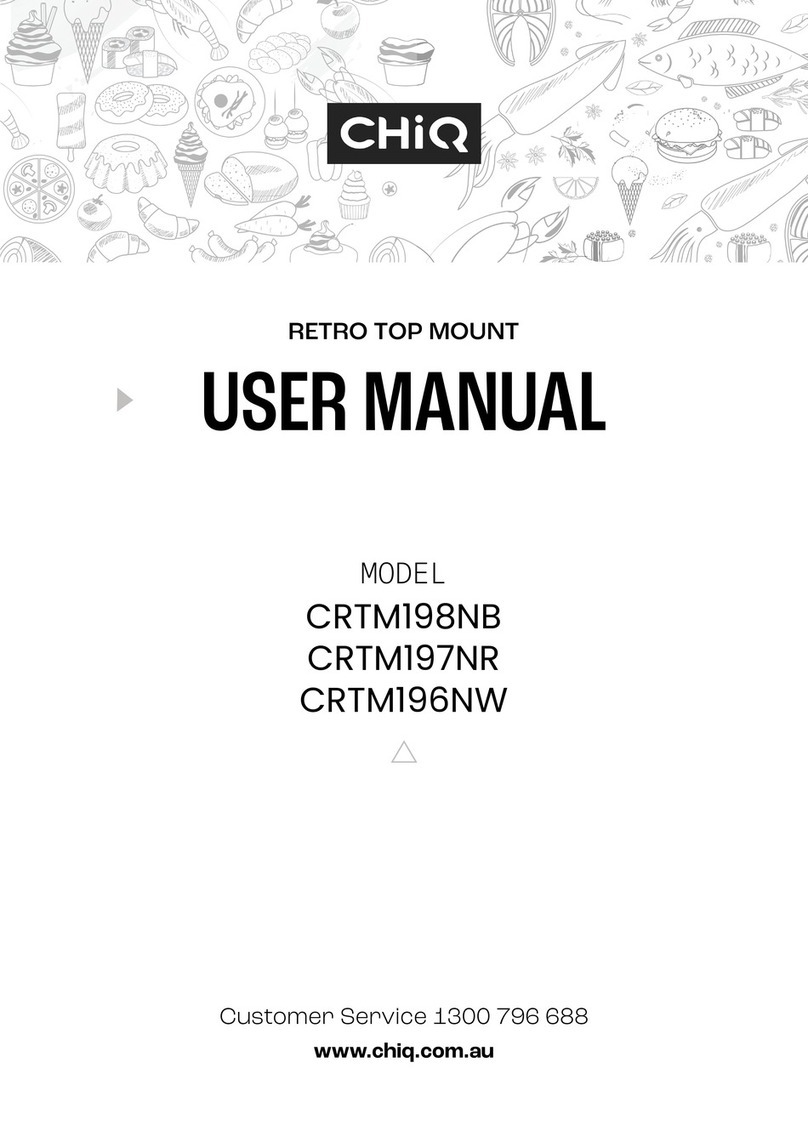
ChiQ
ChiQ CRTM197NR User manual
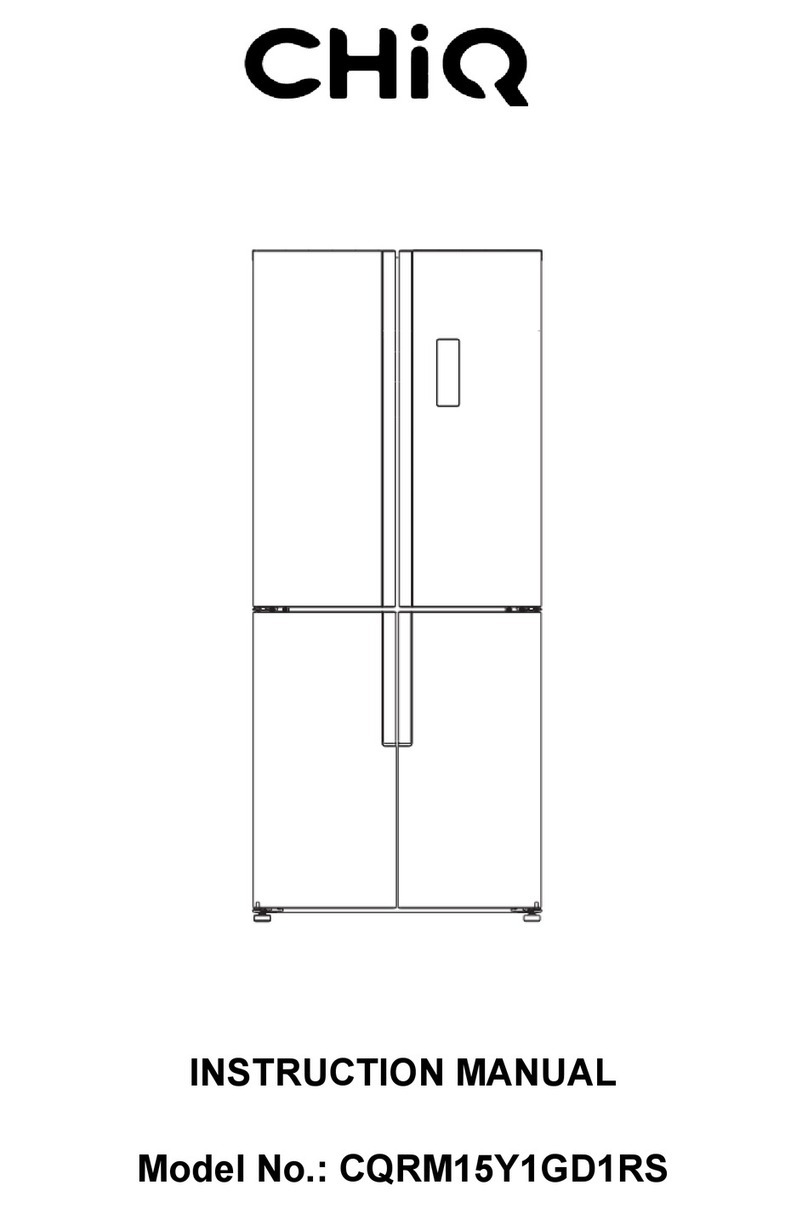
ChiQ
ChiQ CQRM15Y1GD1RS User manual
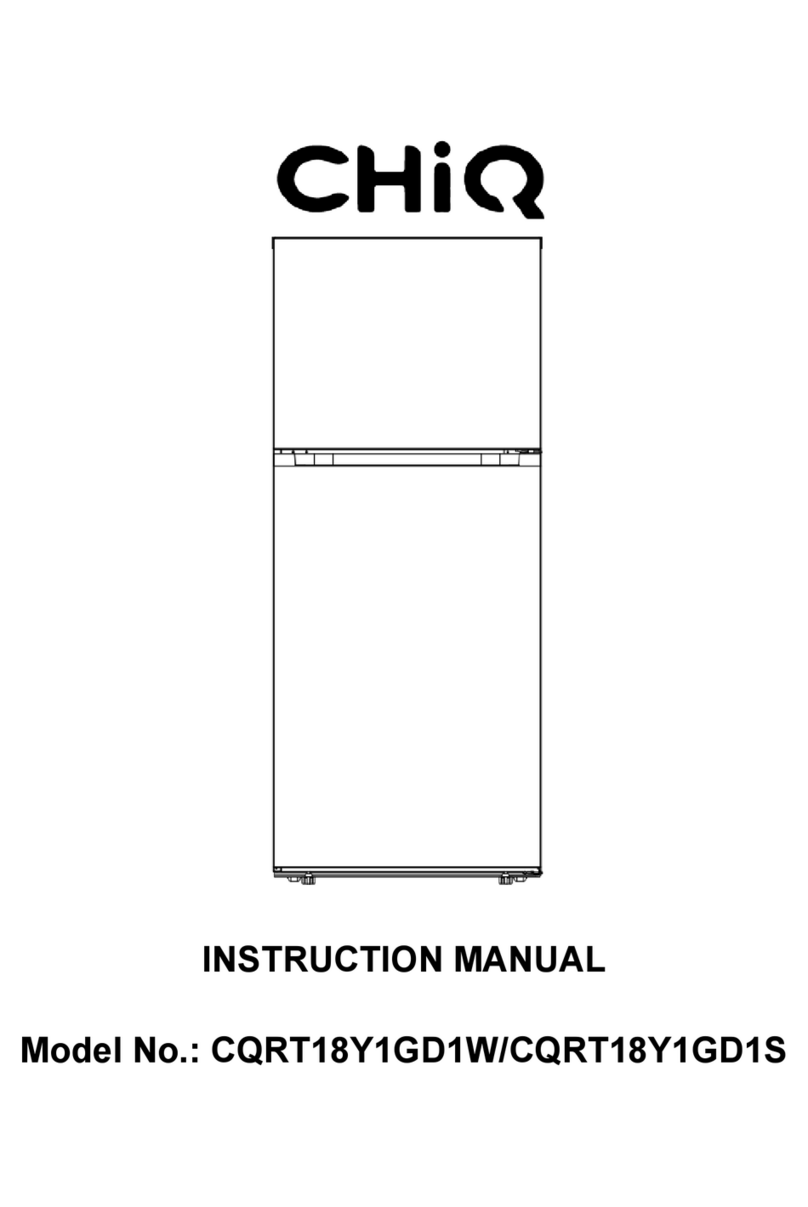
ChiQ
ChiQ CQRT18Y1GD1W User manual

ChiQ
ChiQ CRTM213B User manual

ChiQ
ChiQ CQRD03Z1GD1MR User manual
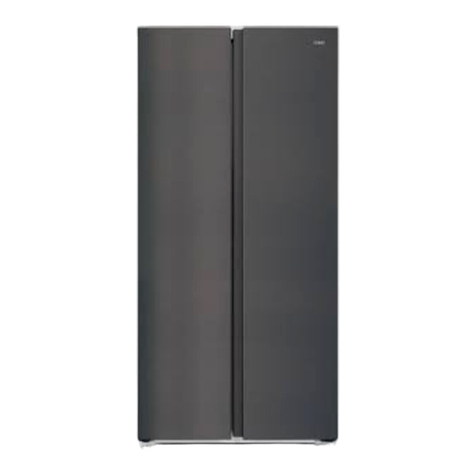
ChiQ
ChiQ MRF-467W User manual
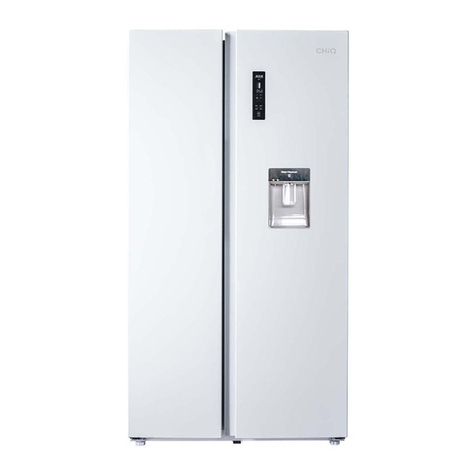
ChiQ
ChiQ CSS559NWD User manual

ChiQ
ChiQ CQRT10Y1GD1W User manual

ChiQ
ChiQ FBM228NE4D User manual
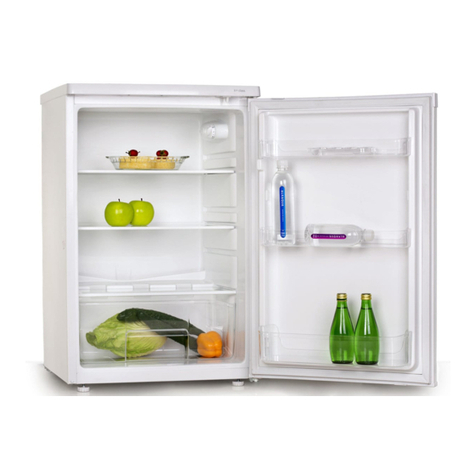
ChiQ
ChiQ CSR129W User manual


